|
|
|
|||
|
|
||||
|
|
||||
| The (Jet)X Files | ||||
|
|
HOME | SITE MAP | FORUM | CONTACT |
|
||
|
ABOUT | MOTORS | MODELS | ARCHIVE | HISTORY | STORE | FAQ | LINKS
|
|
|
|
|
|
|||||||||||||||||||||||||||||||||||||||||||||||||||||||||||||||||||||
|
The (Jet)X Files 24
(December 2004)
by Roger Simmonds Reprinted from SAM 35 Speaks, December 2004 (with corrections) Jetex Jim and other matters It has been some time since ‘Jetex Jim’ has appeared in our esteemed journal, and people have been asking, “What has become of him? Has the old chap been permanently usurped by that flashy parvenu, ‘Rocky Rapier’?” |
|
|||||||||||||||||||||||||||||||||||||||||||||||||||||||||||||||||||||

I am pleased to report that your intrepid rocket reporter has tracked him down, living in happy semi-retirement with that saucy femme fatale of fifties’ Solarbo adverts, ‘Lamina Flo’. I even have a picture of the happy couple. Note that Ms Flo is, despite her sobriquet, quite well turbulated. Rocky, somewhat green with envy, can only look on. I think we can agree JJ looks as chirpy as ever, even if he has, inevitably, put on a little weight. It has been a good year with exciting excursions in a KeilKraft Hunter and a Skyleada Comet, though his long anticipated trip in a Tailored Swift has had to be postponed to next year. However, his wick has been kept dry, he has plenty of fire in his belly and he appears to have lost none of his youthful vigour. Whilst we have folk like Andy Blackwell showing us what he is capable of, I don’t think there is much chance he will be forgotten. |
|
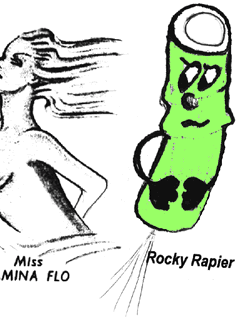 |
||||||||||||||||||||||||||||||||||||||||||||||||||||||||||||||||||||
|
Joe Mansour and the Wilmot brothers, Charles (Bill) and John (Jack), were the founders not only of Wilmot, Mansour & Co., but also of the International Model Aircraft Co., (aka FROG) and Wimco. Their relationship with Lines Brothers is an interesting one that has been |
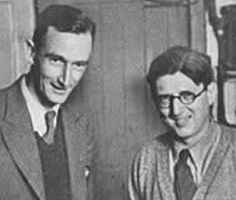
- Lines & Hellstrom, 1989, Frog Model Aircraft
|
|||||||||||||||||||||||||||||||||||||||||||||||||||||||||||||||||||||

Pyrotechnics and Safety |
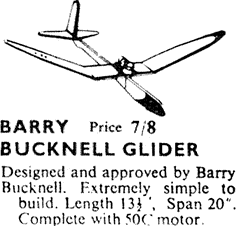
- Jetex brochure, c. 1960
|
|||||||||||||||||||||||||||||||||||||||||||||||||||||||||||||||||||||
|
|
|
|||
|
Lest anyone should think my allusion to ‘hybrid’ rocket motors in October’s column was fanciful, Terry Kidd e-mailed me, “I looked for a website that I remembered had the ‘World’s cheapest hybrid’, a balloon filled with nitrous oxide and rolled paper for fuel. Unfortunately I couldn’t find it. I certainly like the idea of a ‘throttleable’ hybrid motor for Jetex style R/C.” Terry is interested in a topic rather ignored of late: propellant pyrotechnics. Terry comes to Rapiers from a model rocketry background and has been experimenting with ‘home brew’ pellet formulations for Jetex motors based on potassium nitrate and fructose. Perhaps this has heightened his safety awareness, as he has some apposite observations about Rapiers. He writes: “I do have some reservations about safety, possibly unfounded, [but] I’ve heard of a few incidents. Do Rapiers have any way of safely managing overpressures, or does the case just split? Ok if you are 10 yards away firing a rocket electrically, not too good if you are just about to hand launch your pride and joy. The original ICI patent for cardboard Jetex motors [right] showed a cardboard disc [4] at the front ‘popping’ in the event of a 4 atmosphere overpressure. Rapiers seem to have a model rocketry ancestry and perhaps these [safety] considerations were not taken into account in the initial design.” |

- UK Patent Specification 645,897, 1950
|
|||
|
The short answer is, I’m afraid, that that there is no pressure release valve in a Rapier and one of the ceramic ends blows out, or the sides do indeed split. This appears more common with the L1 and the L4. So far there have not been any injuries, but careful inspection of motors before lighting up is a necessary precaution. If the casing appears deformed, the motor is best discarded. Incidentally, I have heard of quite serious accidents (burns) with Jetex motors when used with Powermax (‘Jet-X’) pellets. These absorb moisture easily and burn unpredictably. Terry’s investigations into a safe and more reliable alternative are thus quite timely. A metal case is more amenable to a practical means of safely relieving over-pressure, and the compression springs of the early Jetex motors were a clever, though comparatively heavy, solution. These provided, Andy Blackwell points out, even pressure around the cap. The spring clips of the Jetex 50 and later Jetmaster were lighter and more convenient, but even with optimal tensioning the seal around the cap could be uneven and leaks at right angles to the clips were common. The high powered 50R/HT and Scorpion had two clips to ameliorate this problem. |
||||

They required expert handling of course, and were not a viable commercial proposition, being made especially for Mike’s contest winning helicopters. |
|
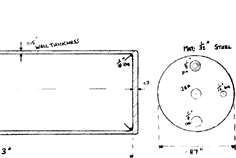
Mike Ingram's 200 ‘contest special’
- Mike ingram |
||
|
The Japanese ‘Tiger’ motors and the US ‘PSST’ motors (distributed by Berkeley) featured variations on the spring clip theme, but the Nevertheless, MA thought the unit a “very well made and powerful job”, but added the proviso: “Constant use and corrosion made the cap difficult to unscrew without the ill advised [!] use of pliers”. The position of the valve is questionable. 
|

- Aeromodeller, Mar. 1955 (p. 154)
|
|||
|
Other examples of the PSST 50 did manage to have their caps in the right
place. Just as potentially hazardous was the powerplant (right) of the German
‘Nova-Jet’, a
delta winged catapult glider. This had a screw cap and carefully knurled
edges to facilitate assembly and disassembly, but again the pressure relief
valve, a “dimpled disc that sealed a small port” was at the wrong
end. Before we leave this discussion of pyrotechnics, a cautionary tale from Bert Judge is pertinent. Terry may find practicable pellets made of rudimentary ‘rocket candy’ suitable for antique motors (i.e. relatively cool burning) more difficult to produce than he thinks. The original fuel formulations were developed with a great deal of expertise, experience and the considerable resources of ICI. Several years later, Jetex were forced to develop their own formulation. They found it no easy task. I’ll let Bert take up the tale: - “When I started at Jetex the cost of the fuel was three pounds fifty for a thousand pellets. It went up to seven pounds a thousand, then to fourteen pounds a thousand and then they wanted to charge twenty-eight pounds a thousand. That was the time when Sebel’s took over. This caused a furore in the company, as there was no way we could buy the pellets at that price. So I said to Joe, “I know we’ve had a Japanese copy of the fuel”, so we tried it out and it burned at a much higher temperature, a bit near the borderline of being dangerous and breaking the engine cases. So I suggested to Joe we analyse this fuel. I knew it was Guanidine Nitrate and Potassium Dichromate and there was a bit of iron in it and one or two other things. So we did loads of tests, because I’m not a chemist and I can only apply logic to a problem. I just went and varied the amounts of the different chemicals we were told were in the original, tabulated the results and came up with a formula. It was decided we would go ahead with that fuel. There was a local firm who had pelleting machinery, so Joe and I went to see them and get their knowledge how we could mix the chemicals and what their machine was, and Joe came back with all the costs and how much we could make the fuel for. “The Sebel fuel obviously wasn’t a patch on the ICI fuel, but it did work and gave you a standard thrust. Before then, when we knew the ICI fuel was being priced out of the market, we went to Brocks [Fireworks] and asked if they could produce a fuel pellet. ‘ Oh yes, no trouble at all’, they said. They tried to give us a fuel pellet that burned at a constant temperature. We checked them and they were fine. ‘Ok’, we said, ‘can you do us a bulk supply?’ The bulk supply was nothing like the original and so after two years we washed them out. “Red Spot fuel was the same basic formulation as the early fuel except that the amount of resorcinol was varied to get a slightly different thrust. The fuel formula was just modified slightly, but it was essentially the same stuff as the ICI fuel. Sebel’s fuel was an orangey yellow colour. Coming back to the cost, the last price [we bought] from ICI was fourteen pounds a thousand. We [Sebel] could make the same number of pellets for fourteen shillings!” I must again thank Bert for this fascinating slice of Jetex history and Andy Blackwell for preparing the transcript. The development of a substitute wick is (as they say) another story! Jet Excess |

- Jim Fackert
|
|||

Free flight sport was also well represented; Andre Bird displayed many of his all-sheet Rapier L4 powered vintage models (all labelled and mounted on stands); we had Nick’s miniature Flaming Ptero, a KeilKraft Star-Jet and Cub, a Jetex 50 Mi-Jet, a Mooncrest biplane [right] and several models from the Eagle Book of Balsa Models including a very nice example of Bill Dean’s ‘Flying Wing’ authentically finished in yellow with USAF markings! [below right] There were even a couple of hydroplanes (one a Hydrojet, which took me back), and a Bluebird car, also, apparently, a plan from the dear old Eagle. We drew a good crowd with visits from at least two editors of the Aeromodeller. Ron Moulton himself was quite complimentary and claimed some of the photographs as his own. It was all good nostalgic stuff, and many a modeller, taken back to his youth, swapped anecdotes from the days of ‘the Barbecue Boys’. I think Chris was well pleased with his enterprise. It should be repeated. |
   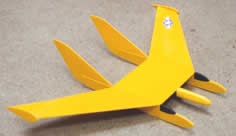
- all photos by Roger Simmonds
|
|||
|
The Editor anticipated my discussion of Pete Smart’s Miles Student (right) by publishing J A Fleming’s 1956 Student in October’s SAM 35 Speaks. This design, like Brian Lewis’ earlier Sipa Minijet (Model Aircraft, 1953) is eyebrow raising in having an enclosed Jetex 100/Jetmaster but no augmenter tube. The plan shows instead a short and unprotected ‘paper tube’: definitely not recommended with Rapiers! Pete’s diminutive scratch built model, nicely detailed and finished in silver, is rather better looking than Fleming’s. Pete hadn’t brought his model to Impington, so I couldn’t examine the motor arrangement at first hand, but I believe the L1, in contrast to Fleming’s design (which I’m not sure actually influenced Pete at all), is more conveniently loaded from above, not below. It is, however, fully enclosed and mounted in a foil-lined duct; the fully functional air intakes, located in the scale position above the cockpit canopy, direct air to the motor. Now, as readers will recall from our discussion of Jetex Tailored models last year, ducts and intakes need to be carefully designed if thrust is not to be impaired. Pete’s model seemed reluctant to fly beyond a powered glide, until, at Richard Crossley’s suggestion, he removed the motor cover. This being so, I wonder how well Fleming’s design flew and how effective his crude paper tube actually was. The Aeromodeller photo shows the model lacked tip tanks and was unpainted (“for the sake of lightness”, which did little for its appearance), so power may have been marginal in this quite bulky design. Andy Blackwell faced a similar situation with his ‘proof-of-concept’ TSR 2. Though the L2 is placed in a foil-lined rectangular tube of generous dimensions and fed by large intakes, thrust appears reduced, and only a series of wallowing ‘belly flops’ has so far been achieved, not the long desired ‘climb out’ to altitude. Andy is contemplating a second prototype with a trough. Our present experiences with enclosed motors does rather emphasise the expertise of the L.S.A.R.A (of whom more later) in the development of the augmenter tube. The large (Jetex 100 powered) Skyleada Comet drew many favourable comments at Impington. Pete said both he and Richard Crossley built reduced versions for Rapier L2s. Despite dihedral, both had a tendency to drop a wing and ‘dig in.’ Andy’s model, in contrast, appears to fly without alarums and excursions. In the early days of Rapiers it was common practice to reduce classic Jetex 50 designs; it is a moot point whether this adversely affected the flying characteristics of a competent design. The Skyleada Javelin for Jetex 50 was a satisfying build, but never an easy design to get to fly well, perhaps because of that ‘tailed delta’ configuration. |

- Pete Smart
|
|||
|
Graham Potter’s reduced Skyleada Javelin for L1 [right] – which wasn’t at Impington either, a great shame as it would have sat very nicely between the Meteor and the Lightning – is also rather unstable: its small size makes it all too easy to overpower, and it will turn one way on one sortie, and then another on the next. Graham obviously likes the design though; impressed by the performance of Mike Stuart’s large Mystère IV, he is building an 11.5" span version for an L2 L.T. I expect this will fly much more predictably. Stan Pearson has ruminated about two evocative jet prototypes of the fifties, viz. the Short S.B.4 Sherpa and the Armstrong Whitworth A.W.52 ‘Flying Wing’. There was, I believe, a profile Sherpa for Jetex 50, which was quite nice in its way, though it lacked the ‘aero-isoclinic’ wing, but the A.W.52 is truly virginal and has not been modelled before. So to stimulate your winter building program, here on the right is a contemporaneous 3-view from Funf’s favourite Jet Aircraft of the World (William Green 1953). Don’t be put off by the planform; despite the harmonisation of pitch and yaw control in the original being a nightmare, it should make for a nice stable model.  Nor should the need for two motors be any impediment to a successful model, given the performance of twins like this very Smart Yak-29P (the pseudo-flying shot [above] is irresistible). About this model Pete says: “it goes splendidly once (or if) you get both L2 LTs burning […] it’s hard to beat the sight of two smoke trails in the sky.” Perhaps Pete should build a Sud-Ouest Trident for an L2 and two L1s: … three smoke trails! |
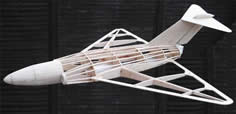
- Graham Potter

- Jet Aircraft of the World, 1953
|
|||
|
Having discussed two models (the Student and Javelin) that weren’t at Impington, I want to finish with one that was – Steve Wadkin’s unique SpaceShipOne for L2 (right). Neither Funf nor I can claim any credit for this, as Steve had not seen October’s column when he drew up the plan and first put knife to balsa. Building, he says, was an interesting experience; the actual aeroplane was evolving quite fast at the time and the model required periodic modifications, for example to the rocket bell. Steve has made a very good job of a challenging and exciting subject. As we anticipated, the booms are indeed quite flexible so stiffeners of thin ply may be necessary; but it is nice and light, there is plenty of area, and Pete gave assurances it would be stable enough even without its small amount of (non-scale) dihedral. I hope Steve will send me a picture of the finished model (I don’t envy him all that complex decoration) and look forward to hearing about its first flights. Does anyone fancy having a go at the ‘White Knight’ mother ship? Jetex and the L.S.A.R.A. References to the Low Speed Aerodynamic Research Association (LSARA) have appeared in SAM 35 Speaks recently (see the Editor’s résumé of D W Allen’s 1954 report, ‘Development of RC for Model Research’ in September’s issue), so this is good time to discuss some of the other collaborations between Jetex and the LSARA. |
 
- Steve Wadkin
|
|||

As part payment for Walker’s services in the development of Jetex motors and augmenter tubes, Bert Judge and Mike Ingram built a large glider [below] for the LSARA’s early experiments with proportional radio control. |
|

- Aeromodeller, Jan. 1960
|
||
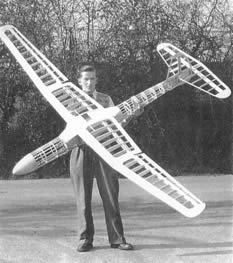
Bert reminisces: ”Walker had a drawing on graph paper showing the outline of what he wanted done. Looking at the picture, we can scale it up from Mike (who is six foot) so it was in excess of eight foot. The design was a joint effort between Mike and myself. I did the drawings, which I still have, and built the fuselage. Mike did the wings. Everything worked out right, we had no trouble and it towed up beautifully. Then it was delivered to the L.S.A.R.A; after that it was powered by a cluster of Jetex 350 motors and later by a petrol engine.” |

- Mike Ingram
|
|||
|
The glider was not the only model Jetex made for the LSARA. Walker accepted a contract from the MOD for two 10-foot Javelins that were later dropped from balloons to test spin recovery. Such a complex project stretched the engineering and financial resources of the LSARA, and according to Bert and Mike, they and their dedicated team made these difficult and (necessarily) accurate replicas after work hours. Though absent in the photo [right], I’m sure they had a tailplane, so perhaps this dubious appendage was removable for some of the tests. I wonder what effect that had on stability and spin recovery. Graham could try this too.  The Jetex team:
The Jetex team:Ron Hutchings, Mike Ingram, Les Kerely, Alec Staines, Pete Cock, Ron Cooper, Bert Judge
- Mike Ingram
And Finally…… |
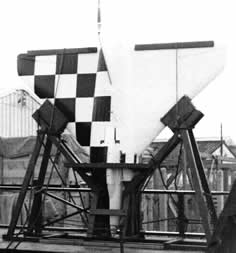
- Mike Ingram
|
|||
|
This is the last (Jet)X Files. After 24 articles and about 50,000 words, I have reviewed most of the historical aspects and contemporary issues that I had in mind when I started, and personal circumstances dictate a reordering of my ‘spare time’. I must thank all those who have contributed photographs, plans and ideas and made the last two years so stimulating. I am thrilled to have met some legendary modellers and to be part of the present ‘micro-jet scene’. Not only have we preserved many vintage models: in making new (though ‘retro’) designs for Rapiers, we have also been able to recapture some of the excitement of those early Jetex days. |
||||
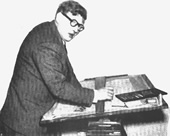
Next month we begin a new, more informal, column, so please keep the correspondence coming. |
 |
|||
|
|
||||
|
|
|
|||
|
|
|
|
|
|
|
|
Acknowledgements - Article: Roger Simmonds - Illustrations: Roger Simmonds, Jim Fackert, Mike Ingram, MAAC archives via Bill Henderson, Terry Kidd |
|
|
|
|
ABOUT | MOTORS | MODELS | ARCHIVE | HISTORY | STORE | FAQ | LINKS |
|
|
Terms of Use
|
Queries? Corrections? Additions?
Please
contact us.
|
|